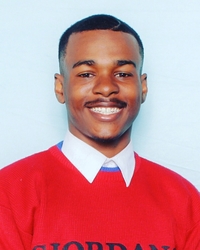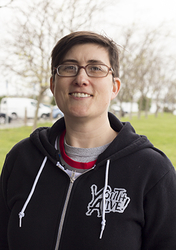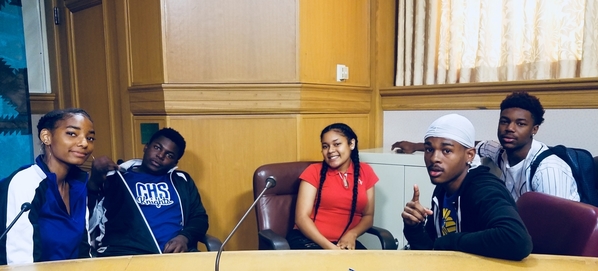Armon Hurst, 2nd from left, first row, Teens on Target, courtesy of YouthAlive!
Eighteen-year-old Armon Hurst serves as vice president of the student body at Castlemont High School in Oakland, Calif. He has a 4.0 grade point average, is an avid baseball player, and is slated to go to college next year.
But until a few years ago, Hurst would find himself waking from nightmares in the middle of the night. It was difficult to concentrate at school, and he wasn’t eating well.

“There was a shooting incident near my house,” says Hurst. Even a year later, he couldn’t get it out of his head.
In 2016, while volunteering for the East Oakland-based YouthAlive!, a nonprofit focused on preventing and healing from violence as well as developing youth leadership, Hurst had a conversation with a staff member that was pivotal.
“He asked me if I went through violence and did it cause trauma,” says Hurst. “And I told him I have. I went through gun violence at least five times in my life and nobody asked me that question.”
That he was asked about it, says Hurst, felt like “a cleanse.” “It was basically stuff that I didn’t tell nobody, and it actually helped.”
That question posed to Hurst was part of a screening tool called the Screening & Tool for Awareness & Relief of Trauma (START). It was developed by YouthAlive! with the help and feedback of youth who had experienced gun violence, researchers from the Center for Non-Violence and Social Justice at Drexel University in Philadelphia, and clinicians from Highland Hospital in Oakland. START includes six questions meant to determine if and how trauma has interfered with young people’s lives and provides them with techniques for dealing with trauma triggers. They’re also given a referral to an in-house mental health worker. And significantly, the staff members, who participate in a four-hour START training, themselves disclose, when applicable, what helps them calm down when they’re overwhelmed.
The self-disclosure by the staff members is one way of building trust, according to a description of the tool on the YouthAlive! website. It “reduces the ‘me vs. them,’ feeling that [boys and men of color] may have, the frequent sense that they are being diagnosed and judged rather than understood and supported.”
When the facilitator, Daniel Roman, first asked Hurst if he had ever experienced trauma, Hurst had to take a long pause before answering.
“It was funny, because he asked me and I tried not to cry, because it was just a lot of thoughts going through my mind. I took a long, deep breath,” recalls Hurst. “I was wondering if I should tell him or not, because the kind of person Daniel is, you know. He’s a good person, the right person for the program because he won’t tell nobody. And he’s actually a calm person, so it seemed like I could trust him.”
“Really, I would just listen a lot of the time,” reflects Roman, who administered START during the pilot and is an intervention specialist for YouthAlive!

The need for such a tool was clear, says YouthAlive! Executive Director Anne Marks. “We had been working with a lot of young men. And, certainly, getting shot wasn’t the first incidence of violence and trauma in their lives,” she says. “They were the walking wounded emotionally, psychologically, if not physically. And we wondered why we couldn’t offer more.”
That Hurst and other young men who live in the area experience community violence is put in stark relief on a map created by the Urban Strategies Council of Oakland. It assigned stressor rankings of communities in Oakland, according to violent incidents and risk of violence. The map shows that East Oakland had among the highest stressor rankings of 57 community police beats.
Instead of starting from scratch, the organization and its research partners repurposed other tools already widely disseminated, says Dr. John Rich, co-director of the Center for Non-Violence and Social Justice at Drexel University.
It includes asking questions about trauma, explains to them how it manifests and gives them widely disseminated tools for managing trauma triggers, such as deep breathing and hand massages, ways to improve sleep, as well as working with the youth to identify and write down a safety plan, explains Rich.
START and the tools it provides these young men is not a cure for the violence, says Rich: “It’s like a little bit of aspirin that helps young people feel a little bit better,” but nonetheless essential. ”While people with means have access to therapies for everyday trauma, these young people don’t have access,” he said.
The six questions that the facilitator asks youth as part of START include: Do you have trouble sleeping or nightmares about stressful experiences? Do you have trouble focusing? Do you feel numb or disconnected from people? Do you feel on guard? Do find yourself avoiding situations that remind you of past stressful experiences?
As it does with all of its research, YouthAlive! had youth who have been victims of gun violence weigh in on the tool, including the language. That yielded some important changes. For example, when adapting a sleep hygiene tool to give to youth as a handout, they wanted to be sensitive to the likelihood that some youth may be homeless or couch surfing. So, they changed the language from saying “your bed” to “your bed or the area where you sleep.”
Similarly, the youth thought that instead of using the word “trauma” when talking to them about their experiences, they preferred the word “stress,” explains Marks. An example is: What causes you stress? What are you stressing about? “It's a less loaded word in terms of what it means,” says Marks.
The START tool was piloted from 2013 to 2014 and included data from one-on-one interactions with 302 young people in Oakland. Ninety percent of the participants were African American or Latino. Sixty-six percent of the participants identified as male and 33 % identified as female, according to a brief describing the START tool.
Of those who participated, 60 percent said they experienced between four and six symptoms elicited by the questions, including: difficulty focusing, hypervigilance, sleep issues, disassociation, avoidance and reexperiencing a traumatic experience through flashbacks or nightmares.
Hurst said he had answered yes to each of the six questions. A particular trigger for him are hearing gunshots. When that happens, he says,“I just take ten seconds and breathe deeply.” The breathing technique was something he picked up in the START interaction. Of the 200 young people contacted four to six weeks after their START interaction, 85% were using a calming exercise they learned, and 94% reported that their symptoms had lessened.
But what was key for Hurst was creating a safety plan for himself, which included listening to music and talking to his parents, which he had not done previously following traumatic incidents.
“Daniel said if you don’t talk to nobody about it, it’s hard to hold trauma. It will be there forever,” he explains. Hurst said he’d been uncomfortable talking to his parents. “I thought the first stuff they’d do would be to yell at me.” But when he opened up, they were responsive. “But they’re calm, and they know how to deal with situations I’ve been through before.”

And Hurst has taken the message of speaking out even further. He talks regularly to middle schoolers in Oakland about his own experiences with gun violence, and how the younger kids can steer themselves away from it as part of the YouthAlive! Teens on Target program.
Another way he’s coped is writing about what he encounters from day to day, as in Hurst's poem called
“LOVE️
🏾
”.
The destruction of my mind is so powerful I look at life and it's so beautiful show me more show me more that's what I want out of life just make it pour
The negative things that go through mind makes a chill up my spine I hate the way this place is I put a fake smile just to keep my family hopes up I can see the people tryna use me for my greatness but I use neglectness
My dad almost died this week god bless his heart wait up I always ask why god always do this to me but granny told me never question god and I see why aqumeni Gemini with peaceful butterflies never attempt to look fly because my community hate wen I try to shine why hate you need to appreciate the ones you love and dedicate yourself to your life to help others be great and when you say grace you have to maintain the space
Never regulate just elevate always meditate you are never straight lemme demonstrate the demons inside my head they’ll make want to go to bed and just sleep instead I always wear red just to show the blood that’s in head
I understand love is not for everyone even when it’s not weighed in tons momma said she love you until you get everything done but thats not fun
To make these rhymes you gotta think about yourself and those lies the pain inside my heart doesn’t even costed a dime to make myself shine to be the best every time yo lyrics gotta be great so people won’t ruin your time my lyrics so sour all you taste is lime.
Thank you for your time and listenin to me and see how I can be free from pain and devastation and relation with realization of life and what it’s bought upon with this hell but with love you can sail
Reflecting on his experiences, Hurst says: “Those traumatic events can destroy your life, but I started thinking about things that make me happy, things that give me the highest feeling where I can just be myself.”




Comments (0)